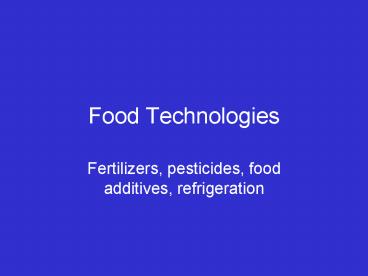Food Technologies - PowerPoint PPT Presentation
1 / 30
Title:
Food Technologies
Description:
Food Technologies. Fertilizers, pesticides, food additives, refrigeration ... food additives to interfere with the chemical reactions that spoil food: ... – PowerPoint PPT presentation
Number of Views:41
Avg rating:3.0/5.0
Title: Food Technologies
1
Food Technologies
- Fertilizers, pesticides, food additives,
refrigeration
2
Food - Natural Production
- Plants use sunlight, water, and carbon dioxide to
synthesize carbohydrates through photosynthesis - Chlorophyll catalyzes the reaction
6 CO2 6 H2O gt C6H12O6 6 O2 - CO2 obtained from air, while water and primary
nutrients (K, N, and P) are obtained from soil
3
Technologies for Growing Food
- Irrigation to augment the water cycle
- Fertilizers to augment nutrients from the slow
natural N and P cycles - Pesticides to decrease the loss of 30 of crops
to insects, weeds, etc. during the growing
process - Recombinant DNA technologies to enhance desirable
traits of food strains
4
Chemical Technology Nitrogen Fertilizers
- Produced by Haber Process - energy intensive
process that combines nitrogen and hydrogen at
high pressures and temperatures in the presence
of an Fe/Fe2O3 catalyst to produce ammonia - N2 3 H2 ltgt 2 NH3
5
Chemical Technology Nitrogen Fertilizers
- Ammonia is oxidized to NO 4
NH3 5 O2 ltgt 4 NO 6 H2O - NO is oxidized to NO2
2 NO O2 ltgt 2 NO2 - NO2 is dissolved in water
3 NO2 H2O ltgt 2 HNO3 NO - Nitric acid is reacted with ammonia HNO3
NH3 gt NH4NO3 (fertilizer)
6
Miller, Living in Environment, 12th,
Brooks/Cole,CA, 2002, 94
7
Chemical Technology Phosphate Fertilizers
- Source is insoluble phosphate rock
- Converted to more soluble compound by reaction
with sulfuric acid Ca3(PO4)2 2 H2SO4 gt
Ca(H2PO4)2 2 CaSO4 - Or, H3PO4 obtained by 2 Ca3(PO4)2 6 H2SO4 gt
H3PO4 6 CaSO4 - Then DAP (diammonium phosphate) is made by H3PO4
2NH3 gt (NH4)2HPO4
8
Sulfuric Acid Plant
Plant produces 1500 tons of sulfuric acid per day
9
Waste By-Product in Manufacture of Phosphoric Acid
Ca3(PO4)2 3 H2SO4 gt 3 CaSO4 2 H3PO4
10
Chemical Technology Pesticides
- Insecticides are chemicals that kill insects
selectively (first were HCN and As-compounds but
not selective) - In 1940's, first selective insecticides were
dichlorodiphenyltrichlroethane, DDT, and
hexachlorobenzene, HCB - Very stable, toxic toward insects, but relatively
non-toxic toward humans
11
Tro,490
12
Tro, 490
13
Chemical Technology Herbicides
- Kill weeds and unwanted plants that can compete
with and dominate crops - Defoliants cause plants to lose leaves
- Agent orange defoliant used in Vietnam war was
banned in 80's due to dioxin (toxic and
carcinogen) contamination - New herbicide, paraquat, does not ac-cumulate in
environment or bioamplify
14
Tro,492
15
Tro,492
16
Modern Herbicide
Does not accumulate in environment nor bioamplify
Tro,492
17
http//pubs.acs.org/hotartcl/chemtech/98/mar/fig1.
html
18
Recombinant DNA Technology
- Recombinant DNA - DNA in an organism that
contains DNA from another organism - Makes it possible to engineer the characteristics
of an organism, called genetically modified
organism, GMO - Have developed plants that are natural-ly
resistant to specific insects
19
Using restrictive enzymes to cut DNA into shorter
pieces
Tro, 420
20
Using gel electrophoresis to separate DNA
fragments according to size
Tro, 420
21
Synthesis and cloning of recom-binant DNA
molecules
Joesten et al, Chemistry, Impact on Society,
Saunders, NY, 1988, 10
22
Technologies for Storage of Food
- Physical technology of refrigeration which lowers
temperature and hence slows reactions that spoil
food - Chemical technologies use food additives to
interfere with the chemical reactions that spoil
food antimicrobial, antioxidants, and
sequestering agents
23
Refrigeration
Birk, Chemistry, Houghton Mifflin, MA, 1994, 375
24
Chemical Technology Antimicrobial Additives
Dehydrating agents - deprive bacteria of water
Tro,486
25
Chemical Technology Antioxidants
(Reducing Agents)
BHT
BHA
Sulfites, SO32-
Tro,486
26
Beta-carotene as an Antioxidant
Joesten et al, World of Chemistry, 2nd, Saunders,
NJ, 1996, 556
27
Chemical Technology Sequestering Agent
Ethylenediaminetetraacetic Acid
Hill/Kolb, Chemistry for Changing Times, 8th,
Prentice Hall, NJ, 1998,595
28
Sequestering agent ties up metals that otherwise
function as catalysts for the oxidation of foods.
Also can tie up toxic metals such as lead.
Hill/Kolb, Chemistry for Changing Times, 8th,
Prentice Hall, NJ, 1998,595
29
Joesten et al, World of Chemistry, 2nd, Saunders,
NY, 1996,560
30
Joesten et al, World of Chemistry, 2nd, Saunders,
NY, 1996,560































